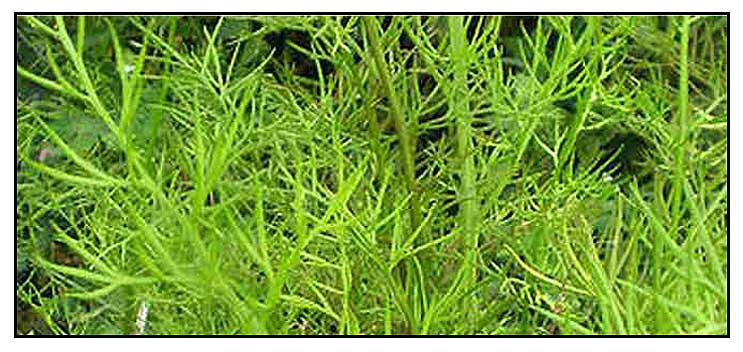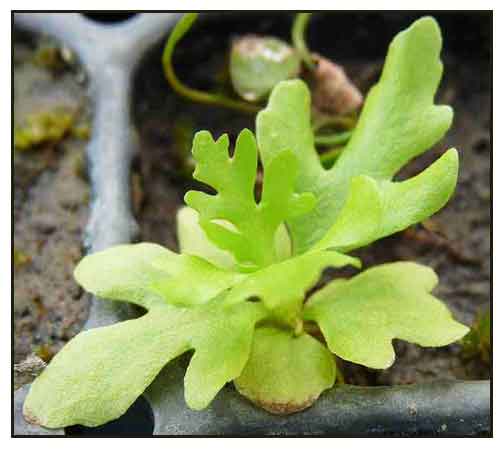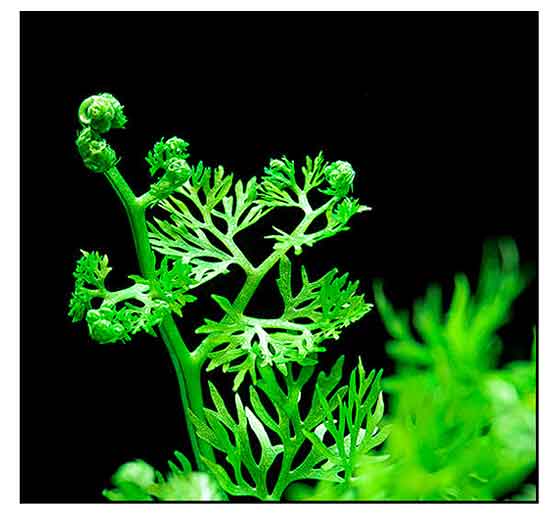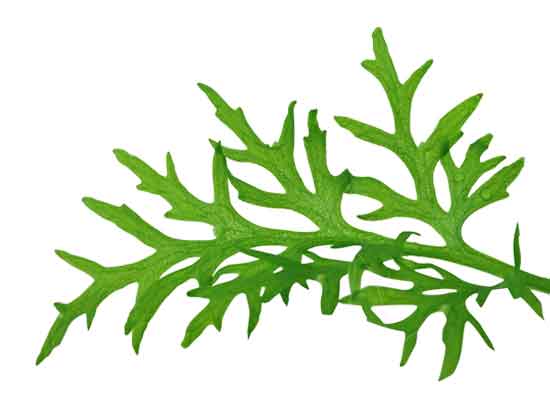|  Gen info Gen info
- The Philippines is home to about 950 species of ferns. Most are referred to as "pako".
- Pako is a local name shared many local medicinal plants: (1) Pako - Athyruyn esculentum (2) Pakong-alagdan Blechnum orientale (3) Pakong-anuang, pako, buhok-virgin, dila-dila
- Onychium siliculosum (4) Pakong-gubat, pakong kalabao, Pityrogramma calomelanos (5) Pakong-parang - Pteris mutilata (6) Pakong-roman - Ceratopteris thalictroides. (7) Pakong-tulog, pakong-cipres, Selaginella tamariscina (8) Pakong buwaya - Cyathea contaminans.
- Ceratopteris thalictroides is a fern species belonging to the genus Ceratopteris, one of only two genera of the subfamily Parkerioideae of the family Pteridaceae.
Botany
Pakong-roman is a floating or loosely rooted aquatic fern, stout, fleshy, tufted with leaves
that are divided into numerous narrow segments. Rhizomes are erect.
Stipes are tufted, thick, naked, and succulent, 3 to 20 centimeters long. Young
plants with sterile leaves are up to 15 centimeters high, with rounded pinnules or
segments, 6 to 8 millimeters wide. The mature plants, which produce only the fertile
fronds, grow up to 70 centimeters high, more compound, with thick, acute, ultimate
segments, 10 to 30 centimeters long, 3 millimeters wide.
 Distribution Distribution
- Native to the Philippines. (10)
- Elsewhere, listed as introduced and naturalized.
-
Widely distributed in the Philippines,
in open waste places, in mud, and in shallow water.
- A
common weed
in rice fields.
- Native range is the Tropics and Subtropics, growing primarily the the wet tropical biome.
(10)
- Also native to Andaman Is., Angola, Assam, Bangladesh, Bismarck Archipelago, Brazil Southeast, Brazil West-Central, California, Cambodia, Caroline Is., Chad, China North-Central, China South-Central, China Southeast, Colombia, Costa Rica, East Himalaya, Ecuador, El Salvador, Ethiopia, Florida, French Guiana, Guatemala, Guyana, Hainan, Honduras, India, Jamaica, Japan, Kenya, Korea, Laos, Lesser Sunda Is., Louisiana, Madagascar, Malaya, Marianas, Mexico Gulf, Mexico Southwest, Mississippi, Mozambique, Myanmar, Nansei-shoto, Nepal, Nicaragua, Nicobar Is., Northern Territory, Panamá, Puerto Rico, Queensland, Solomon Is., Somalia, Sri Lanka, Sudan, Sulawesi, Sumatera, Suriname, Taiwan, Tanzania, Texas, Thailand, Uganda, Venezuela, Vietnam, West Himalaya, Western Australia, Zambia, Zimbabwe. (10)
 Constituents Constituents
- Green parts yield alkaloids, arbutin and tannin.
- Three novel compounds, 13-chlorospelosin 3-O-ß-d-glucopyranoside (1), (3R)-pterosin D 3-O-ß-d-(3'-p-coumaroyl)-glucopyranoside (2), and (2R,3R)-pterosin L 3-O-ß-d-(3'-p-coumaroyl)-glucopyranoside (3) were isolated for the first time from fern species (Ceratopteris thalictroides, H. punctata, N. multiflora, and P. revolutum) along with 27 known compounds. (see study below) (9)
- Phytochemical screening of aqueous extract revealed tannin, saponin, phenolic compounds, and reducing sugar. Acetone extract yielded phenolic compounds, reducing sugar, and steroids. Methanol extract yielded tannin, flavonoids, phenolic compound, and reducing sugar. N-hexane etract only yielded phenolic compounds. Â (11)
- Phytochemical screening of whole plant extracts yielded alkaloids, steroids, coumarin, tannins, saponins, flavonoids, quinone, anthroquinone, phenol, protein, xanthoprotein, carbohydrate, glycosides, catechin, sugar, and terpenoids.
(12)
- Nutrient analysis of young fern leaves (100g edible portion) yield approximately 230 mg protein, 150 mg phosphorus, 150 mg calcium, 120 mg iron, and 300 mg magnesium. Alkaloids, arbutin, and tannin have been found in the green parts. (13)
- Proximate analysis of leaves yielded 13.39% moisture, 13.36% protein, 10.18% ash, 5.54% crude fiber, 54.34% carbohydrate, 3.21% fat, and energy value of 299.69 kcal/100g. Vitamin C was 6.09 mg/100g, sodium 85.20 mg/100g, potassium 1341.30 mg/100g, phosphorus 215.00 mg/100g, magnesium 107 mg/100g, calcium 434 mg/100g, manganese 6.44 mg/100g, iron 58.40 mg/100g, zinc 2.76 mg/100g, and copper 1.19 mg/100g. Antinutritional compounds included oxalate 0.41 mg/100g, phytate 0.36 mg/100g, and hydrogen cyanide 0.15 mg/100g (much lower than reported safe limits). (15)
- Phytochemical screening of leaves yielded alkaloids 0.02 mg/g TAE, saponins 0.01 mg/g, total phenol 14.51 mg/g GAE, tannins 4.29 mg/g TAE, and flavonoids 6.23 mg/g QE, with absence of terpenoids, steroids, cyanogenic glycosides, cardiac glycosides, anthraquinones, and phlobatanins. (15)
Properties
- Tonic and styptic.
- Studies have suggested antibacterial, antiviral, antidiabetic, anticancer properties.
Parts utilized
Whole plant, fronds , leaf juice.
 Uses Uses
Edibility
- Uncurled young leaves are eaten; increasingly popular for use in salads or as substitute for asparagus.
- In Madagascar, eaten like watercress.
- In Malaysia and Japan, an established luxury vegetable.
- In Assam, India, fronds are cooked with pork, an essential dish of Mishing people in all festivals.
Folkloric
- Poultice of leaves used for skin complaints.
- Used as drawing agent in treatment of carbuncles.
- In China, used as styptic to stop bleeding.
- In India, leaf powder along with tumeric is applied to unhealed wounds. Fresh juice of leaves applied on wounds to stop bleeding. In Tamil Nadu whole plant grounded into paste, mixed with tumeric, applied over skin diseases and wounds. (4)
- In North Eastern India, fronds used as poultice in skin diseases. Reported to be toxic and styptic. (5)
Others
- Ornamental: Fish aquarium or pond ornamental, popularly called "water sprite".
- Green manure: Mature plants used as green manure in rice fields.
Studies
• CtCVNH / Novel Anti-HIV Protein: Study investigated the purification and identification of CtCVNH protein. CVN (cyanovirin-N) is an anti-HIV protein; CVNH (cyanovirin-N homology) represents its homology. The purified protein was identified to be the recombinant CtCVNH by Western blot and peptide mass fingerprinting analysis. (6)
• Antibacterial: Study of various fractions of five selected pteridophytes viz. Ceratopteris thalictroides, Christella dentata, Lygodium flexuosum, Pteris vitata, and Salvinia molesta showed antibacterial activity against human pathogens E. coli, S. aureus, K. pneumonia and B. cereus. Chloroform and acetone extracts of C. thalictroides showed maximum inhibitory effect against E. coli. (8)
• Pterosins / Anti-Diabetic Potential: Pterosins are abundant in ferns. Pterosin A is a novel activator of AMP-activated protein kinase, crucial for regulating blood glucose hemostasis. Study yielded three novel pterosin compounds for the first time from four fern species, including Ceratopteris thalictroides, along with 27 compounds. Although all the pterosin analogs exhibited same effects in glucose uptake assays, pterosin A prevented cell death and reduced ROS production. The potential antidiabetic activity of the novel compounds warrants further studies. (see constituents above) (9)
• Antibacterial / Dried Ground Parts: Study evaluated dried and ground plant parts for antibacterial activity using agar well diffusion assay, disk diffusion method, and broth dilution assay. Results showed antibacterial activity against Streptococcus mutans and Shigella flexneri. (see constituents above) (11)
• Anticancer / Shoots: Study evaluated the anticancer potential of methanolic extact of C. thalictroides shoots against various cell lines. HPLC analysis of ME revealed alkaloids as the major component. Elevated levels of active caspase 9, 3, and 8, along with PARP-1, PUMA, MDM2, Ku70 post treatment in leukemic cell line Nalm6 suggested activation of intrinsic and extrinsic pathoways of apoptosis. There was tumor regression in mice bearing breast adenocarcinoma. Results showed anticancer potential in cell lines and mice tumor model, without significant toxicity on normal cells. (14)
Availability
Wild-crafted. |


 Gen info
Gen info




